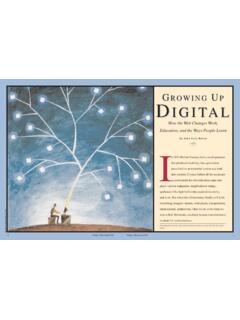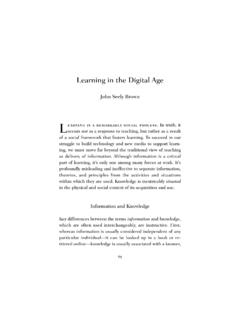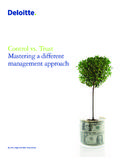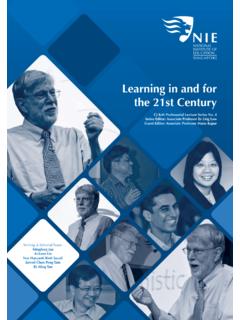Transcription of The University The University in the Digital Age in …
1 The Social Life of InformationJohn Seely Brown and Paul DuguidOther writings by the authors of The Social Life of Information: The University in the Digital Age Times Higher Education Supplement (THES) 1996 May 10: 1-4 Change 1966 July-August: 10-19 About the authors About the site HOME The University in the Digital Age John Seely Brown Paul Duguid Heldref Corp. 1995 Abstract The University 's value, we claim, lies in the complex relationship it creates between knowledge, communities, and credentials. Changes contemplated in either the institutional structure or technological infrastructure of the University should recognize this relationship. In particular, any change should seek to improve the ability of students to work directly with knowledge-creating communities. We offer a couple of examples of currently successful Internet-supported teaching that suggest how technology can do this.
2 Then we explore some hypothetical institutional arrangements that might enable the University to take the fullest advantage of these emerging technological possibilities. 1 Introduction What will the University of the Digital age look like? We really ought to know by now. It's been twenty-five years since Donald Sch n (1971) urged universities to start considering life "beyond the stable state." At about the same time, the futurist Alvin Toffler (1971) confidently predicted that the information age would force universities to accommodate an "accelerating pace of change," prepare for "life-long learning," and even consider "learning contracts" instead of the conventional degree. Since then, there have been a flood of reports on the future of "the University " and a deluge of technological innovations, yet beyond the replacement of the library catalog with computer terminals and the use of PCs as sophisticated typewriters, on many campuses things don't look very different.
3 Ivy and bored students still climb the walls. Perhaps it's just a matter of lag, as an acquaintance suggested to the hypertext guru George Landow (1993): It took only twenty-five years for the overhead projector to make it from the bowling alley to the classroom. I'm optimistic about academic computing; I've begun to see computers in bowling alleys. (p. 161) Page 1 of 29 The University in the Digital Age06/03/2003file://C:\Documents%20and%2 0 Settings\ \My%20 Documents\The% things clearly aren't quite that simple. Universities are rife with computers. Landow himself runs his hypertext projects at the Institute for Research into Information and Technology at Brown University , former home of Ted Nelson. Sch n teaches at MIT, the spiritual parent of such early hi-tech successes as Wang and DEC. Colleagues there include such irreproachable frontiersmen of the Digital age as Nicholas Negroponte, Marvin Minsky, and Bill Mitchell-each of whom is more likely to give you his Home Page URL than a business card.
4 These universities aren't waiting for the superhighway. They form its major intersections. So the lack of apparent change in University life in the past 25 years isn't simply a matter of computational backwardness. It's probably truer to say universities are schizophrenic, a combination of high-powered computational centers and highly conventional institutional practices. Indeed, the advanced technological infrastructure of a University is itself probably as good an indicator of a certain strain of institutional conservatism as any. Those institutions that were able to accumulate the resources (financial, intellectual, social) to develop a computer-intensive infrastructure were most likely to be large, wealthy, and above all (despite Sch n's pleas) profoundly stable. After all, building the Internet wasn't a job for the 7-11 franchise.
5 It's important to note right away, the sources of this institutional conservatism aren't found only in the easy-to-criticize administrative bureaucracies. Tenured faculty, for both good and bad reasons, tend to cling to the institutional and disciplinary sources of their own hard-won security. It took an English academic to say to one of us "We've done things this way for five-hundred years, why should we change now?" but similar currents of conservatism run through American faculty senates. Alumni and parents, too, don't always encourage change (Arenson, 1995). They've paid a lot for a chunk of tradition and often refuse to be cheated out of it. This is surely why at commencement, a ceremony more for parents than for anyone else, the campus abounds with mediaeval costumes and dead languages. And while business, which as the dominant customer for the universities' graduates has significant influence, might congratulate itself on being a force for change, Motorola and MacDonald's universities and most industrial training programs don't offer very bright alternative horizons.
6 Nonetheless, for all the institutional inertia, universities are changing-primarily because their "environment" is changing. The conventional 18-to-22-year-old undergraduate going through a parent's paycheck and school in four consecutive years is becoming increasingly rare and unconventional. Members of increasingly diverse student bodies no longer have the time, the patience, or the money to obey the universities' implicit command to assemble at conventional campuses for Page 2 of 29 The University in the Digital Age06/03/2003file://C:\Documents%20and%2 0 Settings\ \My%20 Documents\The% periods, for conventional forms of teaching. (Many of these conventions are not much younger than the costumes and customs of commencement.) People are taking up their degrees later and over longer periods, assembling them out of one course here and a few credit hours there, snatched between jobs and bank loans, when time, money, interest, and opportunity arise.
7 It's probably less helpful, then, to say simply that the University will change because of changing technologies than to say the emerging computational infrastructure will be crucially important in retooling the already changing University and in providing access to these students of tomorrow. So, what might a reformed, post-millennial University that has adapted to this changing environment look like? Some suggest that it won't so much "look" as "be"-that the University of the future will be a virtual place with no need of the physical campuses that have marked a University for so long. We, however, doubt that the University will dissolve into cyberspace so easily. The idea of the virtual University , we suspect, both underestimates how universities as institutions work and overestimates what communications technologies do. Learning, at all levels, relies ultimately on personal interactions and, in particular, on a range of implicit and peripheral forms of communication that technology is still very far from being able to handle proficiently (Brown & Duguid, 1994).
8 Of course, communications technology will undoubtedly support and transform many of the interactions of researchers and students, teachers and learners. Moreover, its marginal cost is also much cheaper than the conventional classroom. Undoubtedly, its contribution to the University of the future will be immense. Yet the feasibility and financial viability of technological intervention are, we believe, as much issues for concern as celebration. Implemented without due understanding of the institutional character of educational forms, intervention might only further polarize an already divided system. For instance, rather than disappearing, the conventional campus with all its rich and respected resources could easily become the reserve of those who can afford it. Those who cannot would be offered the Net as their alternative. And though catalogs might claim that such an education and the degrees granted would be virtually the same, we suspect they would be materially different.
9 The Net degree, though it might command the same letters ( , , , etc.), would almost certainly not command the same respect as its distant campus cousin. In consequence, despite all the claims that the Net is a means to overcome inequality, the already steeply tiered system of higher education would probably become only further divided by the unequal financial resources of its students. Page 3 of 29 The University in the Digital Age06/03/2003file://C:\Documents%20and%2 0 Settings\ \My%20 Documents\The% alternative approach, and one more in tune with the way people learn, is not to divide the student body between those who get the chance to go to school and those who are given only the opportunity to go on line. Rather, it may be wiser to consider ways to divide each student's career between time better spent on campus or in communities and time better spent on-line-so that all may have the opportunity to experience the best of both worlds.
10 To achieve a democratic expansion of the system will require, however, quite different pedagogical paradigms than delivering "education" and quite different administrative arrangements than simply establishing ever more "Open Universities." It will also require, we suggest, acknowledging the strengths and resources of the current system and using technology in support of these, not in opposition or as an alternative. So, in contrast to those who suggest that the University of the twenty-first century will not so much "look" as "be," we argue below that it may be better to think of it "looking" in many ways surprisingly similar but "being" very different, because the most profound changes may be those made in the institutional arrangements rather than the physical infrastructure that makes up what people think of as a University . Our own view of what the University of the next millennium may look like isn't based simply on a naive desire for a more rather than less egalitarian system of education.





